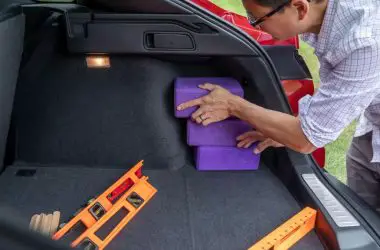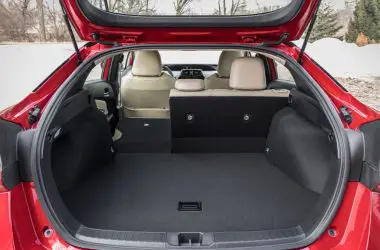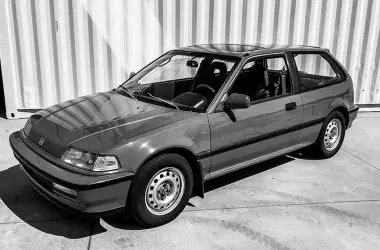What is Boot Space?
Boot space, also known as trunk space, refers to the storage capacity available in the rear cargo area of a vehicle. It is typically measured in liters or cubic feet and is an important specification for consumers when comparing different vehicle models.
Boot space provides room to store luggage, groceries, outdoor gear, and other items, making it an essential practical consideration, especially for families or those who frequently carry bulky loads. The larger the boot, the more cargo volume there is to accommodate belongings and gear.
When calculating boot space, measurements account for the area reachable through the opening at the rear of the vehicle. The space may extend partly under the rear seats in hatchbacks and estate cars. Boot space does not include the cabin area where passengers sit.
Having ample boot space ensures there is sufficient room to store items securely. A spacious, square-shaped boot also allows owners to optimize the available space. Boot space capacity is therefore an important specification to research when shopping for a new or used car.
How Boot Space is Measured
Boot space is typically measured in liters or cubic feet to indicate the total volume and carrying capacity. The most common metric used is liters (L).
To calculate the boot space, measurements are taken of the length, width, and height of the cargo area. These measurements account for the maximum dimensions of the boot with any adjustable or foldable rear seats in the extended position. The formula for calculating volume is length x width x height. This total cubic capacity indicates the total potential space available for storing luggage and cargo. According to Skoda, even the space beneath the luggage compartment floor is included in the official boot space measurement.
Some key dimensions measured include:
- Length – Distance between back of rear seats and inside edge of tailgate
- Width – Widest point between wheel wells
- Height – Floor to roof at tallest point
By taking these key interior dimensions and calculating the cubic capacity, automakers can quantify and communicate the total boot space capacity in a standard liters measurement. This allows easy comparisons between different vehicle models and classes when evaluating cargo and luggage needs.
Typical Boot Space Sizes
Boot space can vary significantly depending on the size and type of vehicle. Here are some general guidelines on typical boot space sizes:
Small cars, such as city cars and superminis, usually have boot spaces ranging from 200-400 liters. For example, the MINI Hatch has a boot capacity of 211 liters according to CarBuyer.
Medium cars like family hatchbacks and compact SUVs generally have boot spaces from 380 to 550 liters. The Volkswagen Golf, a popular family hatchback, has a boot capacity of 380 liters as listed on Volkswagen’s website.
Large cars such as executive saloons and large SUVs tend to have boot capacities ranging from 450 to 650+ liters. For example, the Audi A6 Avant estate has a maximum boot capacity of 605 liters according to Audi’s price list.
Extra large vehicles like MPVs and full-size SUVs can have boot capacities upwards of 650+ liters. The Ford Galaxy, a popular MPV, has a boot capacity of 765 liters as listed on Ford’s spec sheet.
Largest Boot Spaces
When maximum cargo capacity is a top priority, certain models stand out for their exceptionally large boot spaces. The Toyota Innova Crysta has one of the most spacious boots in its class, with up to 1,047 liters of cargo volume in the top trim levels. For a midsize sedan, the Honda City is surprisingly roomy, with 536 liters of trunk capacity. Moving into the compact SUV segment, the Renault Duster comes equipped with a 475 liter boot. Lastly, minivans like the Maruti Suzuki Ertiga can pack up to 209 liters behind the third row, expanding to 550 liters with the rear seats folded.
These models cater to buyers who routinely transport larger items or have ample luggage for leisure trips and road trips. The abundance of cargo space reduces the need for roof racks or trailers when packing for vacations or moving homes. For reference, most average sedan boots provide between 300-400 liters of capacity, so the vehicles mentioned here far exceed that level.
Smallest Boot Spaces
When looking for a small car, boot space is often compromised. Models known for having the smallest boot spaces include:
- Smart Fortwo – With just 260 liters (9.2 cu ft) of cargo capacity, the Smart Fortwo has one of the smallest boots of any car (AutoEvolution). The two-seater design prioritizes compactness over cargo.
- Fiat 500 – At 185 liters (6.5 cu ft), the boot of the Fiat 500 is truly tiny. Rear seats folding down expand capacity, but space remains very limited (AutoEvolution).
- Mazda MX-5 – The Mazda MX-5 roadster has a boot of just 130 liters (4.6 cu ft). This two-seat convertible prioritizes driving experience over practicality.
- Toyota Aygo – The Aygo’s teeny tiny 168 liter (5.9 cu ft) boot makes it one of the smallest in its class (Auto Dimensions).
While these models offer little cargo room, their compact size and maneuverability make them suitable city cars. Drivers wanting more space should look to larger hatchbacks and compact SUVs.
Factors That Impact Boot Space
There are several factors that can affect the usable boot space in a car.
One key factor is the ability to fold down the rear seats. Cars that allow the rear seats to fold completely flat or tumble forward can greatly expand the boot space. For example, the Honda Jazz increases its boot space from 354 liters to 881 liters when the rear seats are folded.
The size of the wheels and tires also impacts usable boot space. Larger wheel diameters and wider tires eat into the available cargo room. For example, upgrading from 16-inch to 18-inch alloy wheels often reduces boot space by around 5% or more.
The shape and design of the boot itself is a big factor. Hatchbacks and estate cars tend to offer more usable space due to their boxier shapes. Sedans and SUVs sometimes have more awkwardly shaped boots that make it harder to fit bulkier items.
Many cars also have hidden storage areas under the floor of the boot to utilize all available space. Features like under-floor compartments, side bins, cargo nets, and more help maximize usable cargo capacity.
Maximizing Usable Boot Space
There are several creative ways to maximize the usable boot space in your vehicle. This is especially important for smaller cars with limited cargo capacity. The key is using storage solutions that fully utilize all the nooks and crannies of your boot.
One simple solution is to use plastic storage bins, fabric organizers, and other compartmentalized containers. These allow you to neatly stack and arrange items for optimal use of vertical space. Collapsible organizers are also great for flexibly dividing your boot when needed [1].
You can also install custom boot fittings like side cubbies, under-floor storage, and cargo nets on the roof or sides. Multi-level cargo trays or boards help create an extra “floor” to stack items on. Boot-mounted hooks allow you to hang grocery bags upright. Inflatable products like air mattresses can conform to unused space when deflated [2].
When packing your boot, start by placing bulky lightweight items like blankets toward the back. Then pack heavier items like tools forward, and secure in place with tie-downs. Take advantage of the passenger cabin as well, using seatback organizers and securing some items on top of seats. With a bit of creativity and organization, you can maximize every inch of storage space.
Comparing Boot Space Between Models
When choosing a new car, boot space is an important consideration for many buyers. After all, you’ll want to make sure your vehicle can accommodate your luggage, groceries, sports equipment, and other cargo.
There are a few ways to compare boot space between different car models:
- Look at the litre capacity – Most manufacturers provide the total boot volume in litres. This allows you to directly compare the size between models.
- Check the dimensions – Length, width, and height measurements (in cm or inches) can give you a sense of shape and usefulness of space.
- Compare images – Pictures of the boot with boxes or bags can provide a visual sense of capacity.
- Try it out – Loading a stroller, golf clubs, etc. into the boot in person can help assess real-world utility.
Apart from pure size, also consider the boot opening, cargo cover, compartments, and other aspects that impact convenience and versatility.
Online tools like Carwow’s boot size comparison and RAC’s guide allow you to visually compare the boot dimensions between makes and models.
While boot capacity won’t be the only deciding factor, evaluating and comparing boot space will ensure your new car provides adequate room for your needs.
Boot Space and Luggage Capacity
Boot space refers to the total volume capacity of a vehicle’s rear storage area, while luggage capacity refers to how much luggage can actually fit into that space. So what’s the relationship between the two?
While boot space provides a maximum volume, the usable luggage capacity is often lower for several reasons:
- The boot may not be a perfect rectangle, limiting how bags and suitcases can be packed.
- Wheel arches and other intrusions take up space.
- A spare tire, tools, and other equipment may be stored in the boot.
- Groceries and other cargo can be irregularly shaped.
- Passengers’ legs restrict how far forward luggage can be placed.
As a result, many automakers now provide luggage capacity figures in liters or cu. ft. in addition to boot space. For example, a vehicle may have 18 cu. ft. of boot space but only handle 5 medium suitcases, or 15 cu. ft. of luggage capacity. Review luggage capacity specs to understand how much can really be packed in.
Boot organizers, storage bins, and other accessories can help maximize usable space. But when luggage capacity is much lower than total boot space, the vehicle layout itself limits loading flexibility. Understanding the difference between these two measures helps set realistic expectations when shopping for a new vehicle.
Future of Boot Space
The future of boot space in cars is expected to see some interesting trends and innovations, with automakers focusing on maximizing cargo capacity in clever new ways. According to this article, upcoming models in 2024 and 2025 will likely utilize space more efficiently through reconfigurable and adjustable interiors.
For example, some EV startups are developing models where the backseats can fold completely flat and even be removed altogether to transform the car into a van-like cargo area. Rear passengers seats may also become more adjustable, allowing the seat backs to recline fully flat to accommodate larger items.
Other innovations coming down the pipeline include cars with front trunks (“frunks”) to supplement the main rear cargo area, smarter storage compartments built into the vehicle floor, and load floors that can be height adjusted or segmented into sections. Automakers are also making boot entrances wider and lower to the ground to enable easier loading.
In general, cargo capacity and practicality will become greater focuses in EV design, as range anxiety decreases and consumers desire more flexible, livable interior spaces. While electrification poses some challenges for boot space, advancements in battery technology will help free up more interior room too. The future boot promises to be more functional and accommodating than ever.





